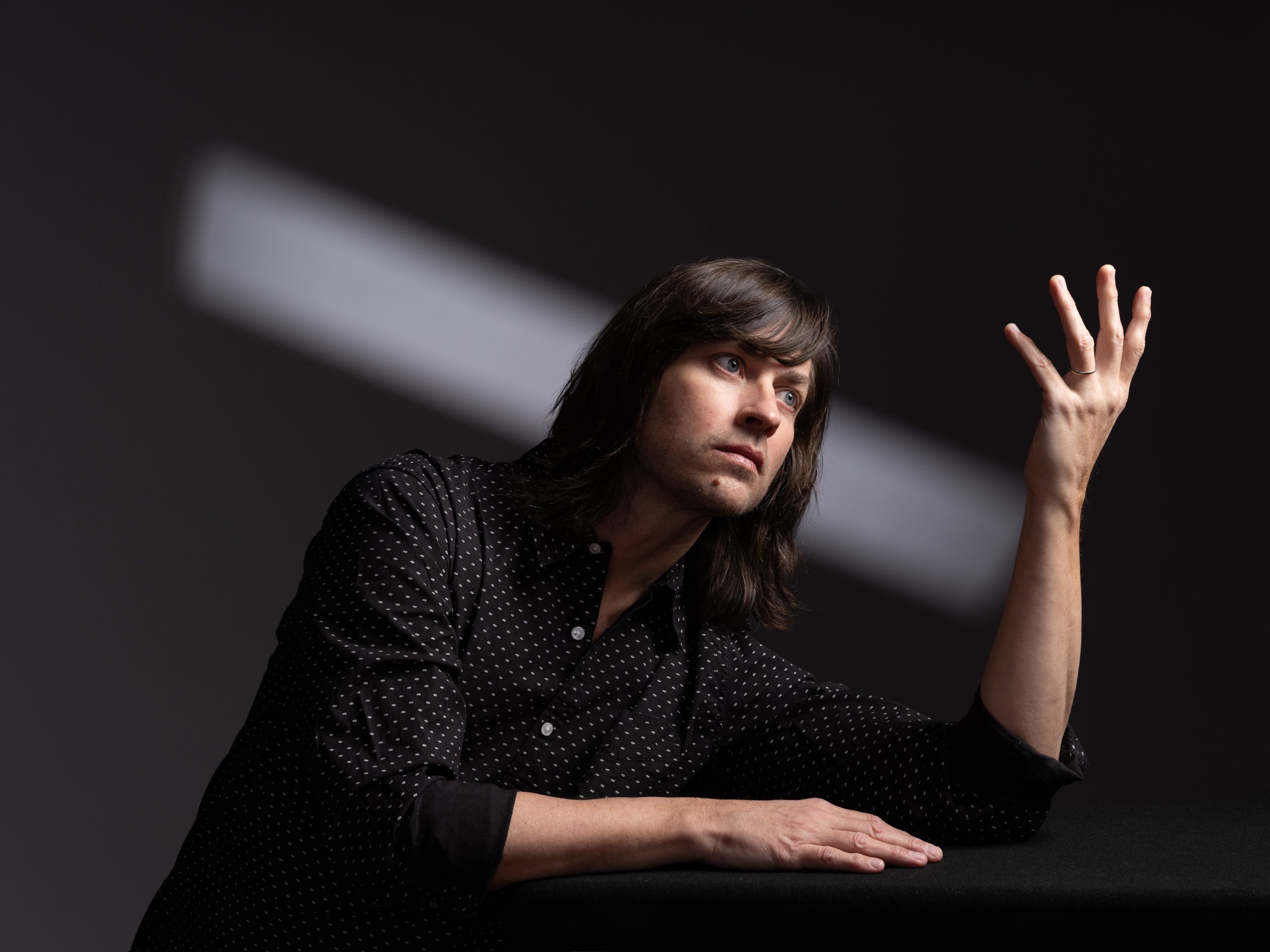Click Image to Download!
The latest full-length from Rhett Miller, The Misfit, exists in an enchanted dimension all its own. With its elegant blurring of psychedelia, dream-pop and electronic-leaning indie-rock, the Texas-bred singer-songwriter’s ninth solo effort emerged from a charmed collaboration with his Hudson Valley neighbor Sam Cohen, the sought-after producer known for his work with innovators such as Kevin Morby and Danger Mouse. And while the album often wanders into decidedly cosmic terrain, Miller grounds each track with the vulnerable songwriting and unaffected vocal presence he’s brought to his role as frontman for legendary alt-country band Old 97’s for the last three decades. The result is a body of work fully attuned to the tension of modern times, yet imbued with all the lovely delirium of a dreamscape.
“Making this album was the closest thing I’d ever experienced to being part of something magic,” says Miller, noting that The Misfit came to life after a long period of creative inertia. “Like a lot of artists to whom I’ve spoken, there was a hopelessness that had set in during the pandemic, which led me to question whether there was a point to writing songs anymore,” he recalls. But in a burst of inspiration, Miller eventually approached Cohen about continuing the musical partnership they’d begun on his 2018 album The Messenger. “I had a feeling we could collaborate on a more fundamental level than Sam polishing up my songs, and he presented the idea of meeting daily to write together and make something different from anything I’d done before,” Miller says. “It turned into a routine where every morning I’d leave home and drive over the mountain to his house, and by that evening we’d have a rough mix of a new song. The speed of creation was absolutely wild; in some ways I can’t even believe it happened.”
Produced by Cohen at his own Slow Fawn Studios (a former horse farm in the hamlet of Accord), The Misfit is deeply rooted in a shared intention to “make a record that lives in a world with no rules,” according to Miller. “As we were working we kept returning to the relationship between David Bowie and Brian Eno and the records they made together, and how fearless they were in their approach to finding the songs,” he adds. In shaping The Misfit’s elaborately detailed sound, Cohen handled all the instrumentation, playing guitar, bass, drums, and keys in addition to sculpting the album’s mercurial rhythms and textures with lavish use of synth and drum machines. Featuring the background vocals of Cassandra Jenkins and Annie Nero on several tracks, the outcome is an unexpected yet undeniably potent setting for Miller’s lyrical storytelling. “One of the things I love about working with Sam is that his instincts are very much complementary to mine,” says Miller. “He has this ability to create music that’s open and eerie and beautiful, and at the same time allows for a propulsiveness that makes it feel so vibrant and vital.”
The first song Miller and Cohen created for The Misfit, “Heart Attack Days,” opens the album with a sublimely loopy rumination on the troubled state of the world. “That song started when I was visiting the Dallas neighborhood where I’d spent my formative years, which is now gentrified to the point of being unrecognizable,” says Miller. “I was looking out at all the construction and came up with those first two lines: ‘Sunset on a wrecking ball/Killing time while it’s mine to kill.’” An immediate catalyst for their highly exploratory collaboration, the sonic foundation to “Heart Attack Days” began with a synth-heavy demo that Cohen sent to Miller in the earliest stages of the album-making process. “There’s this shattered synth line where a chord gets delayed and arpeggiated and sounds like it’s exploding, and I fell in love with it right away,” says Miller. “It felt like the musical equivalent of the narrator’s experience, and it became a song about all the ways we busy ourselves and try to give meaning to the waning hours of our time on the planet.”
In making the case for taking whatever beauty you can find in a chaotic world, The Misfit next drifts into the dreamy melancholy of “Follow You Home,” a piano-laced piece of self-reflection exploring the gulf between expectation and reality, its mood infinitely brightened by Jenkins and Nero’s luminous vocals. “When you’re young, you imagine a perfect scenario for how your life will unfold, and of course it doesn’t turn out that way,” says Miller. “I never thought I’d live out in the country north of New York City, or that I’d be one of only a handful of middle-class musicians who are able to make a good living. ‘Follow You Home’ came from wrestling with the idea of home as a place I never would’ve pictured—and yet I can’t imagine having wound up anywhere else.”
The cinematic centerpiece to The Misfit, “Beautiful Life,” arrives as one of the album’s most transportive moments. “Of all these songs, that’s the one least altered by my collaboration with Sam,” says Miller, who wrote “Beautiful Life” on guitar at a park in Brooklyn. “His main contribution was taking it from the pop-song realm into this sprawling landscape with all this aural space and a couple of heavy counterpoint chords, and it became one of the songs I’m most proud of.” Graced with his offbeat poetry (at one point rhyming “hydrangea,” “stranger” and “change her”), “Beautiful Life” also underwent a profound shift in personal meaning for Miller. “As I was writing it I let myself take on a different character, someone who’s in unrequited love and trying to convince himself that it’s going to work out,” says Miller. “But once I’d finished, I realized it was about telling myself to open up to the good things that come to me, instead of believing it’s all doomed. It’s like a trick my brain pulled to lull me into writing something that’s become a mantra of self-encouragement, and I’m so grateful for that.”
All throughout The Misfit Miller reveals his voracious imagination as a lyricist, an element exquisitely showcased in the sweetly heartbreaking “Following the White Tops.” “I wrote that song after reading an essay about turn-of-the-century circus life and all the people who’d get drawn into that world and spend their lives in a caravan of likeminded weirdos,” he says. Narrated by a trapeze artist hopelessly in love with the star of the freak show, “Following the White Tops” takes place in the split-second moment before its protagonist meets a tragic end. “He’s flying through the air and realizing he’s not going to reach the fingertips of the catcher, and the safety net isn’t properly secured because he and the carnies had gone out and tied one on the night before,” Miller explains. “As he’s falling to his death he sees the girl he loves and the man she’s chosen to be with, a ‘prominent clown’ at the top of the circus hierarchy. In one way it’s this weird, silly song about a circus, but in writing it I felt so invested in this story lamenting a lost opportunity for love that it felt real.”
In selecting the cover art for such an idiosyncratic body of work, Miller reached out to globally renowned painter Ashley Longshore. A longtime fan of Longshore, he first linked up with the pop artist via his podcast, “Wheels Off.” “I knew The Misfit needed a cover that was otherworldly in its colors and its feel, so I contacted Ashley knowing it was a long shot,” says Miller. “But she connected with the songs, and the piece she created was so beautiful and thoughtful and perfect. It adds a whole new level of artistry to the album, and now anyone who gets the vinyl can have an Ashley Longshore painting of their own.”
Arriving almost exactly 20 years after The Instigator (his Jon Brion-produced solo major-label debut), The Misfit takes its title from a gloriously spacey but self-scrutinizing track called “Just When It Gets Good.” “It was the first song I wrote in the pandemic, at a time when I didn’t know where I fit anymore,” he says. “There are always so many voices in our head trying to keep us from making art, and I was definitely falling prey to their ill effects.” Noting that “feeling like a misfit is the artistic condition,” Miller ultimately found his sense of purpose wholly restored by the making of The Misfit. “I’ve toyed with some other disciplines, like writing short-form fiction, long form fiction, essays and children’s books,” says Miller, whose latest kids’ book The Baby Changing Station is due out this fall from Little Brown Young Readers. “They all fulfill something in me, but nothing compares to songwriting. The idea that you can sit down and create a whole universe and then put it out into the world—the joy I get from that quick-hit creation will always be unmatched for me.”







